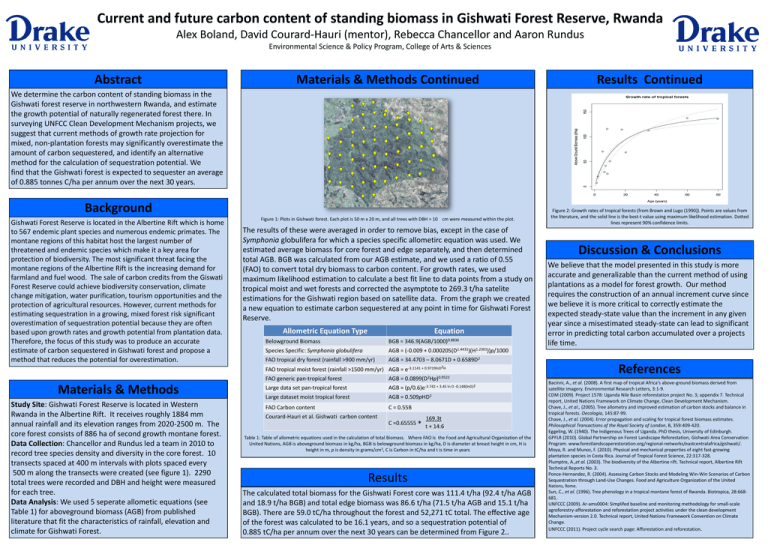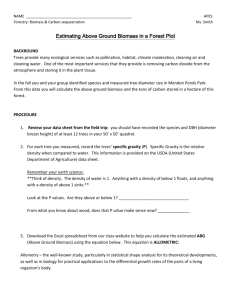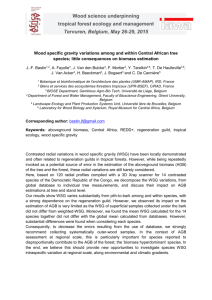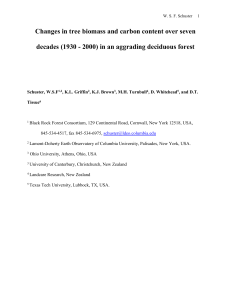Poster 25 - eScholarShare
advertisement

Current and future carbon content of standing biomass in Gishwati Forest Reserve, Rwanda Alex Boland, David Courard-Hauri (mentor), Rebecca Chancellor and Aaron Rundus Environmental Science & Policy Program, College of Arts & Sciences Abstract Materials & Methods Continued Results Continued Figure 1: Plots in Gishwati forest. Each plot is 50 m x 20 m, and all trees with DBH > 10 cm were measured within the plot. Figure 2: Growth rates of tropical forests (from Brown and Lugo (1990)). Points are values from the literature, and the solid line is the best-t value using maximum likelihood estimation. Dotted lines represent 90% confidence limits. We determine the carbon content of standing biomass in the Gishwati forest reserve in northwestern Rwanda, and estimate the growth potential of naturally regenerated forest there. In surveying UNFCC Clean Development Mechanism projects, we suggest that current methods of growth rate projection for mixed, non-plantation forests may significantly overestimate the amount of carbon sequestered, and identify an alternative method for the calculation of sequestration potential. We find that the Gishwati forest is expected to sequester an average of 0.885 tonnes C/ha per annum over the next 30 years. Background Gishwati Forest Reserve is located in the Albertine Rift which is home to 567 endemic plant species and numerous endemic primates. The montane regions of this habitat host the largest number of threatened and endemic species which make it a key area for protection of biodiversity. The most significant threat facing the montane regions of the Albertine Rift is the increasing demand for farmland and fuel wood. The sale of carbon credits from the Giswati Forest Reserve could achieve biodiversity conservation, climate change mitigation, water purification, tourism opportunities and the protection of agricultural resources. However, current methods for estimating sequestration in a growing, mixed forest risk significant overestimation of sequestration potential because they are often based upon growth rates and growth potential from plantation data. Therefore, the focus of this study was to produce an accurate estimate of carbon sequestered in Gishwati forest and propose a method that reduces the potential for overestimation. Materials & Methods Study Site: Gishwati Forest Reserve is located in Western Rwanda in the Albertine Rift. It receives roughly 1884 mm annual rainfall and its elevation ranges from 2020-2500 m. The core forest consists of 886 ha of second growth montane forest. Data Collection: Chancellor and Rundus led a team in 2010 to record tree species density and diversity in the core forest. 10 transects spaced at 400 m intervals with plots spaced every 500 m along the transects were created (see figure 1). 2290 total trees were recorded and DBH and height were measured for each tree. Data Analysis: We used 5 seperate allometic equations (see Table 1) for aboveground biomass (AGB) from published literature that fit the characteristics of rainfall, elevation and climate for Gishwati Forest. The results of these were averaged in order to remove bias, except in the case of Symphonia globulifera for which a species specific allometirc equation was used. We estimated average biomass for core forest and edge separately, and then determined total AGB. BGB was calculated from our AGB estimate, and we used a ratio of 0.55 (FAO) to convert total dry biomass to carbon content. For growth rates, we used maximum likelihood estimation to calculate a best fit line to data points from a study on tropical moist and wet forests and corrected the asymptote to 269.3 t/ha satelite estimations for the Gishwati region based on satellite data. From the graph we created a new equation to estimate carbon sequestered at any point in time for Gishwati Forest Reserve. Allometric Equation Type Equation Belowground Biomass BGB = 346.9(AGB/1000)0.8836 Species Specific: Symphonia globulifera FAO tropical dry forest (rainfall >900 mm/yr) AGB = (-0.009 + 0.000205(D1.4431)(H1.2301))p/1000 AGB = 34.4703 – 8.0671D + 0.6589D2 FAO tropical moist forest (rainfall >1500 mm/yr) AGB = e-3.1141 + 0.9719lnD2H FAO generic pan-tropical forest AGB = 0.0899(D2Hp)0.9522 Large data set pan-tropical forest AGB = (p/0.6)e-3.742 + 3.45 ln D -0.148(lnD)2 Large dataset moist tropical forest AGB = 0.509pHD2 FAO Carbon content Courard-Hauri et al. Gishwati carbon content C = 0.55B C =0.65555 * 169.3t t + 14:6 Table 1: Table of allometric equations used in the calculation of total Biomass. Where FAO is the Food and Agricultural Organization of the United Nations, AGB is aboveground biomass in kg/ha, BGB is belowground biomass in kg/ha, D is diameter at breast height in cm, H is height in m, p is density in grams/cm3, C is Carbon in tC/ha and t is time in years Results The calculated total biomass for the Gishwati Forest core was 111.4 t/ha (92.4 t/ha AGB and 18.9 t/ha BGB) and total edge biomass was 86.6 t/ha (71.5 t/ha AGB and 15.1 t/ha BGB). There are 59.0 tC/ha throughout the forest and 52,271 tC total. The effective age of the forest was calculated to be 16.1 years, and so a sequestration potential of 0.885 tC/ha per annum over the next 30 years can be determined from Figure 2.. Discussion & Conclusions We believe that the model presented in this study is more accurate and generalizable than the current method of using plantations as a model for forest growth. Our method requires the construction of an annual increment curve since we believe it is more critical to correctly estimate the expected steady-state value than the increment in any given year since a misestimated steady-state can lead to significant error in predicting total carbon accumulated over a projects life time. References Bacinni, A., et al. (2008). A first map of tropical Africa's above-ground biomass derived from satellite imagery. Environmental Research Letters, 3:1-9. CDM (2009). Project 1578: Uganda Nile Basin reforestation project No. 3; appendix 7. Technical report, United Nations Framework on Climate Change, Clean Development Mechanism. Chave, J., et al., (2005). Tree allometry and improved estimation of carbon stocks and balance in tropical forests. Oecologia, 145:87-99. Chave, J., et al. (2004). Error propagation and scaling for tropical forest biomass estimates. Philosophical Transactions of the Royal Society of London, B, 359:409-420. Eggeling, W. (1940). The Indigenous Trees of Uganda. PhD thesis, University of Edinburgh. GPFLR (2010). Global Partnership on Forest Landscape Reforestation, Gishwati Area Conservation Program. www.forestlandscaperestoration.org/regional-networks/eastcentralafrica/gishwati/. Moya, R. and Munoz, F. (2010). Physical and mechanical properties of eight fast-growing plantation species in Costa Rica. Journal of Tropical Forest Science, 22:317-328. Plumptre, A.,et al. (2003). The biodiversity of the Albertine rift. Technical report, Albertine Rift Technical Reports No. 3. Ponce-Hernandez, R. (2004). Assessing Carbon Stocks and Modeling Win-Win Scenarios of Carbon Sequestration through Land-Use Changes. Food and Agriculture Organization of the United Nations, Rome. Sun, C., et al. (1996). Tree phenology in a tropical montane forest of Rwanda. Biotropica, 28:668681. UNFCCC (2009). Ar-ams0004: Simplifed baseline and monitoring methodology for small-scale agroforestry-afforestation and reforestation project activities under the clean development Mechanism-version 2.0. Technical report, United Nations Framework Convention on Climate Change. UNFCCC (2011). Project cycle search page: Afforestation and reforestation.











